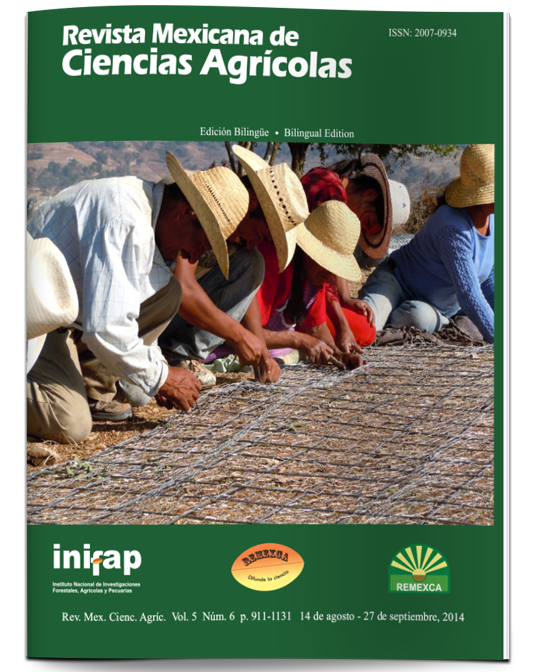Detection of black bean lines with adaptation in the humid tropics of southern Mexico
DOI:
https://doi.org/10.29312/remexca.v5i6.878Keywords:
Phaseolus vulgaris L., yield, stability, diseasesAbstract
In the Bean Improvement Program of the Experimental Station from INIFAP in Cotaxtla, the breeding method by introduction has been effective generating varieties for the humid tropics of southern Mexico. From 2007 to 2010, a trial was conducted in four environments from Veracruz and one in Chiapas, in order to determine the adaptation of 14 black bean lines from the Escuela Agricola Panamericana de Zamorano and the University of Puerto Rico, along with varieties Black Tacana and Black Jamapa as control, to identify lines with highest yielding and widely adapted to this region. The trial was conducted in a randomized block design with three replications. It was recorded genotype reaction to diseases that are present naturally on the environment: angular leaf spot and bean golden yellow mosaic virus, plant mortality was recorded by the incidence of systemic necrosis and grain yield was determined. Five lines were located in the outstanding yield group (p≤ 0.05), which were stable in their behavior (bi= 1 and S2di = 0) and showed adaptability to environmental conditions in which beans are produced in the humid tropics of Veracruz and Chiapas. The X02-33-147-2 line was the most productive with 1 400.4 kg ha-1; which average yield was significantly higher than Black Tacana and Black Jamapa (regional controls). The same line also showed resistance to angular leaf spot and tolerance to bean golden yellow mosaic virus.
Downloads
Downloads
Published
How to Cite
Issue
Section
License
The authors who publish in Revista Mexicana de Ciencias Agrícolas accept the following conditions:
In accordance with copyright laws, Revista Mexicana de Ciencias Agrícolas recognizes and respects the authors’ moral right and ownership of property rights which will be transferred to the journal for dissemination in open access. Invariably, all the authors have to sign a letter of transfer of property rights and of originality of the article to Instituto Nacional de Investigaciones Forestales, Agrícolas y Pecuarias (INIFAP) [National Institute of Forestry, Agricultural and Livestock Research]. The author(s) must pay a fee for the reception of articles before proceeding to editorial review.
All the texts published by Revista Mexicana de Ciencias Agrícolas —with no exception— are distributed under a Creative Commons License Attribution-NonCommercial 4.0 International (CC BY-NC 4.0), which allows third parties to use the publication as long as the work’s authorship and its first publication in this journal are mentioned.
The author(s) can enter into independent and additional contractual agreements for the nonexclusive distribution of the version of the article published in Revista Mexicana de Ciencias Agrícolas (for example include it into an institutional repository or publish it in a book) as long as it is clearly and explicitly indicated that the work was published for the first time in Revista Mexicana de Ciencias Agrícolas.
For all the above, the authors shall send the Letter-transfer of Property Rights for the first publication duly filled in and signed by the author(s). This form must be sent as a PDF file to: revista_atm@yahoo.com.mx; cienciasagricola@inifap.gob.mx; remexca2017@gmail.
This work is licensed under a Creative Commons Attribution-Noncommercial 4.0 International license.



